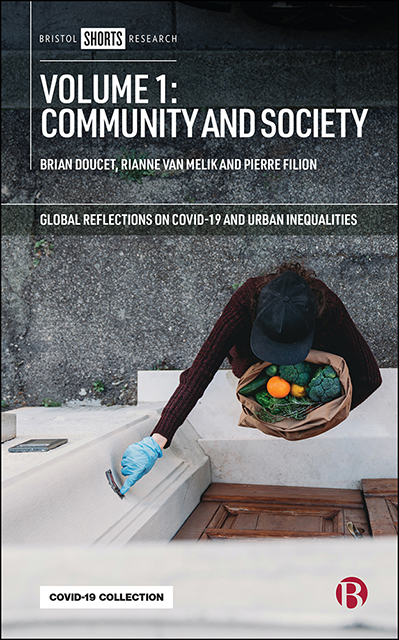Book contents
- Frontmatter
- Contents
- List of Figures and Tables
- Notes on Contributors
- Acknowledgments
- Preface to All Four Volumes of Global Reflections on COVID-19 and Urban Inequalities
- One Introduction
- Part I Working Practices
- Part II Life During Lockdown
- Part III Migration, Migrants, and Refugees
- Part IV Age, Race, Gender, and Ability
- Index
Four - The Hidden Inequities and Divisions among Workers in the US: The Domestic Workers’ Workforce as Non-Essential Workers
Published online by Cambridge University Press: 13 April 2023
- Frontmatter
- Contents
- List of Figures and Tables
- Notes on Contributors
- Acknowledgments
- Preface to All Four Volumes of Global Reflections on COVID-19 and Urban Inequalities
- One Introduction
- Part I Working Practices
- Part II Life During Lockdown
- Part III Migration, Migrants, and Refugees
- Part IV Age, Race, Gender, and Ability
- Index
Summary
Introduction
The COVID-19 pandemic has laid bare the many ways in which domestic workers (housecleaners, nannies, and caregivers) remain undervalued, unprotected, and invisible across US cities. Over 2.2 million domestic workers in the US – 91.5 percent of whom are women – today face profound challenges and risks. As their employers take safety measures to practice social distancing, the so-called ‘low-touch’ economy has become widespread, and in April 2020 left 68 percent of domestic workers surveyed with no jobs according to the National Domestic Workers Alliance (NDWA) national survey (NDWA, 2020a).
At the same time, the vast majority of domestic workers are excluded from the protections of key federal labor laws and standards, including the right to minimum wage and those protections guaranteed under the Occupational Safety and Health Act (OSHA) and the Family Medical Leave Act. Currently, only ten US states and the city of Seattle have passed the Bill of Rights for Domestic Workers and yet, they lack Personal Protective Equipment (PPE) and are at the good disposition of employers who choose to pay them while they are not working. All these aspects combined constitute strong limitations for improving domestic workers’ working conditions.
This chapter aims to provide an overview of the demographics, wages, benefits, and poverty living conditions of the domestic workers who, despite being on the frontlines of the pandemic, caring for the sick, and keeping homes clean, are yet not publicly recognized as essential workers. In addition, this work highlights the complex relationship between employer-employee and some of the incredible work that non-for-profit organizations across US cities have undertaken in order to improve domestic employees’ working conditions and advocate for better workers’ rights.
Key demographics on domestic workers and working conditions in the US
Feminists have long pointed to ways in which care work is privatized and devalued. Now we are witnessing an intensification of these processes in ways that affect us all deeply. Today, a disproportionate amount of care work is carried out by minority ethnic, immigrants, and women. Care work is itself ‘systematically devalued as the feminized, private work of home, rather than as society's work’ (Lawson, 2007: 2). The following study speaks volumes about how we need to start building new forms of relationships, institutions, and actions that enhance mutuality, well-being, and constructive engagement.
- Type
- Chapter
- Information
- Volume 1: Community and Society , pp. 41 - 50Publisher: Bristol University PressPrint publication year: 2021

